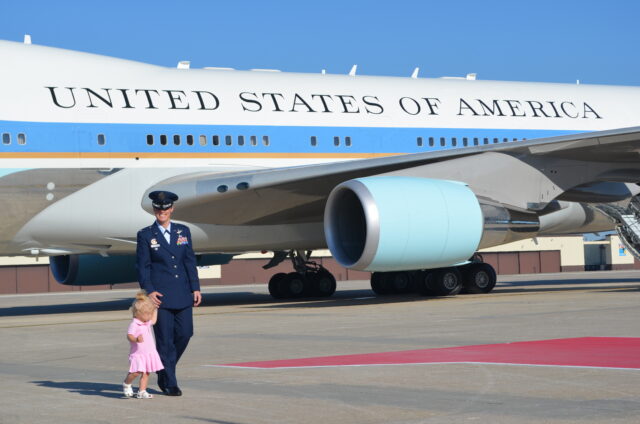Brigadier General Kristin Goodwin‘s career has been one of breaking barriers and pioneering new frontiers in the military, particularly in the realm of space defense. As one of the key architects of the United States Space Force, Kristin Goodwin’s influence in shaping the newest branch of the military has left an indelible mark on the nation’s defense strategy. From her role in establishing the Space Operations Command (SpOC) to her leadership in space defense, Kristin’s experience spans high-stakes operations, organizational restructuring, and global coordination. Today, her efforts continue to resonate in the operational framework of the U.S. Space Force.
A Groundbreaking Role in the Formation of the U.S. Space Force
Kristin Goodwin’s story is deeply intertwined with the creation of the U.S. Space Force, a historic milestone in military strategy. When General Jay Raymond called upon Goodwin to serve as Chief of Staff in 2020, she faced the challenge of bringing the 11th combatant command—Space Operations Command—into operational readiness. With a timeline that normally would have required 18 months, Goodwin’s team completed the mission in just eight months. “It was an unprecedented challenge,” she recalls, “but it was also an incredible honor to be part of something so historic.”
As Chief of Staff for SpOC from 2020 to 2022, Kristin led a team of 4,100 personnel, supporting 38,000 space and cyber professionals across 134 global locations. Her role wasn’t just about managing large-scale operations—it was about creating something new and transformative. The Space Force, as a new branch, required more than just administrative oversight; it demanded leadership that could envision and build the operational structures that would support space defense for decades to come.
The Architecture of Space Operations Command
One of the defining aspects of Kristin Goodwin’s leadership was her focus on innovation within the organizational structure of SpOC. Tasked with setting up a new command, Goodwin implemented a strategic restructuring that replaced the traditional 15-layer military hierarchy with a more efficient five-layer framework. “The goal was to create a more agile, responsive organization that could act swiftly in critical moments,” Kristin explains. This shift helped streamline communication and decision-making, allowing the command to respond to space-related threats in real-time.
Goodwin’s approach to organizational design wasn’t just about reducing bureaucracy—it was about creating an environment where space defense operations could operate at the speed of necessity. “The goal was to get critical intelligence to operators as quickly as possible, enabling them to execute missions faster and more effectively,” she reflects. The reorganization laid the groundwork for a Space Force that could keep pace with the rapidly evolving landscape of space technology and threats.
Space Operations in a New Era: Kristin Goodwin’s Strategic Leadership
Kristin’s leadership style is rooted in a deep understanding of strategy, which she developed throughout her military career. Prior to her role at SpOC, Goodwin was Chief of Staff for the Joint Force Space Component Command, where she helped build the U.S. Space Command. Her earlier experience as Director of Transformation at NORAD & USNORTHCOM allowed her to develop a comprehensive view of space operations in relation to homeland defense, particularly in response to growing competition from countries like China and Russia.
Her work at SpOC involved not only designing the infrastructure but also managing the day-to-day operations that sustained the newly-formed command. “Building SpOC from the ground up wasn’t just about structural changes,” she notes. “It was about ensuring that we had the right policies, the right people, and the right systems in place to make sure we could carry out the mission effectively.” Kristin’s focus on comprehensive strategy execution involved everything from managing corporate partnerships to overseeing contractor performance and ensuring resource allocation aligned with SpOC’s mission objectives.
From Air Force Command to Space Force Leadership
Kristin Goodwin’s transition to leading the U.S. Space Force was built on a foundation of strong leadership within the Air Force. Her extensive experience as a command pilot, logging over 2,900 hours in various aircraft including the B-52 and B-2 Stealth Bomber, provided her with a practical, hands-on understanding of high-pressure military operations. However, it was her groundbreaking role as the first female to command a Bomb Wing in the U.S. Air Force that truly solidified her reputation as a leader capable of navigating complex environments and demanding missions.
“I had always known how to navigate challenges,” she reflects, “but when I transitioned to Space Force leadership, I found that some of the old approaches didn’t quite fit the new mission. It required adapting, rethinking, and evolving the way I led.” Her ability to adapt her leadership style to the unique needs of the Space Force was pivotal in her success.
Leading Through Complexity: Kristin Goodwin’s Legacy at SpOC
The complexity of space defense operations required Kristin to think not just about the immediate needs of the Space Force but also about its long-term sustainability. Her leadership extended beyond structural reforms to encompass human capital management, policy development, and the integration of various defense technologies. Under her guidance, SpOC became responsible for overseeing the life cycle sustainment of the U.S. Space Force’s space and cyberspace systems, as well as managing resource planning and budgeting for operations across the globe.
“What excited me most was the opportunity to build something that would have a lasting impact on U.S. defense operations,” Kristin notes. “The systems and infrastructure we put in place continue to guide how the Space Force operates today.” Her oversight of policy, personnel programs, and readiness efforts provided a holistic framework for sustaining U.S. space defense operations in the long term.
Transitioning Leadership from Air Force to Space Force
Kristin’s leadership journey culminated in her role as Deputy Commanding General for Support at Headquarters Space Operations Command, where she continued her work overseeing human capital development, policy creation, and strategic operations management. However, her journey did not stop there. After retiring from the Air Force, she transitioned into the private sector as an advisor and COO, offering her expertise in governance, technology transformation, and risk management to companies in the space, defense, and technology sectors.
Today, Kristin Goodwin’s work at TechWise, where she serves as Chief Operations Officer, allows her to continue impacting the space defense landscape from a new perspective. Her ability to bring a military mindset to private-sector solutions makes her an invaluable asset to the companies she advises. “At TechWise, I help companies and organizations navigate complex challenges related to space defense,” she says. “It’s a natural extension of the work I did in uniform, helping the military adopt cutting-edge technologies and strategies to stay ahead of the curve.”
Kristin Goodwin’s Continuing Impact on Space Defense
Kristin Goodwin’s work continues to influence the U.S. Space Force, which benefits from the infrastructure and leadership models she helped create. As one of the foundational leaders in the establishment of the Space Force, her strategic vision and leadership have left an indelible mark on America’s ability to defend its interests in space.
Her leadership, from her Air Force command days to her pivotal role in the creation of the Space Force, has shaped the very foundation upon which the newest military branch operates today. Kristin Goodwin’s journey has been one of transformation, from commanding a Stealth Bomber to leading the future of space operations, and her contributions will continue to guide the U.S. Space Force for years to come.
As the Space Force evolves, the operational systems and organizational frameworks Kristin helped put in place remain critical to America’s ability to maintain its leadership in space defense. Her legacy, built on vision, precision, and an unwavering commitment to excellence, continues to serve as the backbone of the Space Force’s mission to protect U.S. interests in the space domain.
By Chris Bates










